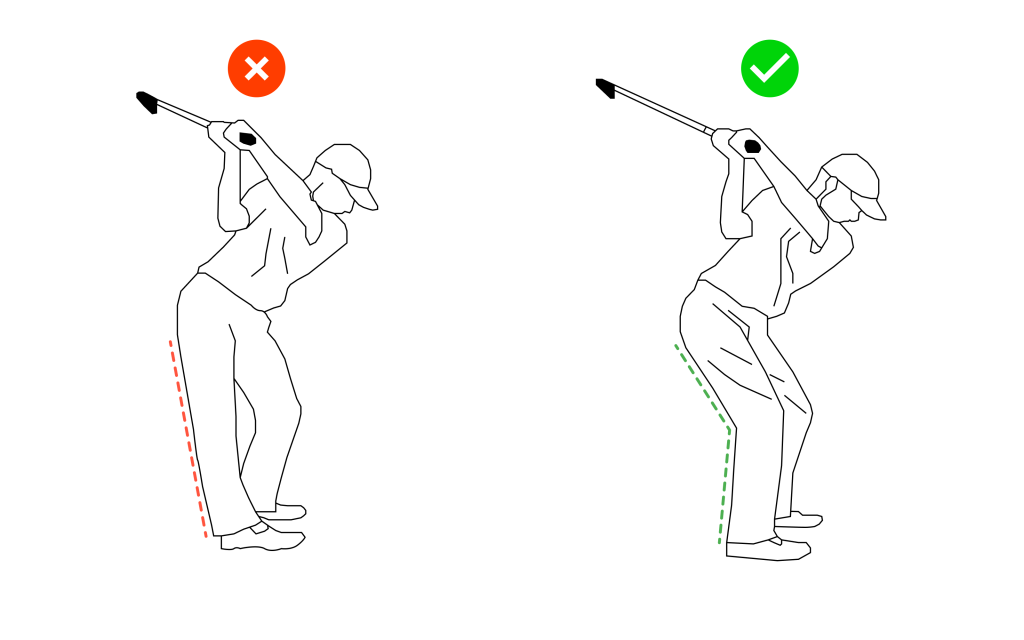
Locking the right knee in the backswing is an excessive straightening of the leg, creating a rigid stance. This restricts weight transfer and hip rotation, forcing an upper-body swing, resulting in power loss and inconsistent ball striking.
Causes of Locking Right Knee in Golf Backswing
Mentioned Below are the technique related issue along with the physical limitations for the error:
- Incorrect weight distribution at address
If a golfer starts with too much weight on the right side, they’re predisposed to maintaining that weight on the right throughout the backswing. This makes it challenging to allow the knee to flex naturally and facilitates locking. - Lack of proper hip rotation in the backswing
The backswing should initiate with hip rotation, allowing the right knee to flex slightly. If the hips are restricted, the body compensates by straightening the right leg, attempting to create a “turn” through rigidity rather than proper rotation. - Trying to “lift” the ball with the upper body instead of rotating
Many golfers mistakenly believe they need to lift the ball into the air. This misconception leads to an upper-body dominant swing, where the right leg is locked to provide a “stable” base for lifting, rather than creating a rotational power source. - An overly rigid or tense setup
A tense setup, with locked knees and tight muscles, inhibits the natural flow of the swing. If the right knee is already braced at address, there is very little room for it to flex during the backswing.
Drills to help avoid the issue
1. Lead Knee Control Drill (Bucket/Box Drill) –
Trains proper knee flex and movement for improved lower body mechanics to improve lead knee control, maintain flex, and promote proper rotation without swaying or collapsing posture.
2. Hip Rotation Awareness Drill –
Helps you feel and train proper hip rotation in the backswing to develop awareness of correct hip rotation and tilt during the backswing for a more powerful and stable swing.
Physical Limitations With Exercises to Improve
- Limited hip mobility and rotation:
Tight hip muscles may limit movement resulting in locking of right knee to adjust.
– Exercises – Side lounges, hip stretching, 90/90 stretch. - Tight hamstrings:
Tight hamstrings can limit flexibility and range of motion making it difficult to achieve knee flex.
– Exercises – Static stretch, seated hamsting stretch, foam rolling. - Lack of Core Strength:
Limited core strength makes it difficult to maintain proper posture and weight distribution.
– Exercises – Plank, side plank, russian twist. - Lack of back flexibility:
Weak muscles and lack of flexibility can hinder the ability to control and move the lower body in swing.
– Exercises – Chin tucks, neck rotation, shoulder blade squeeze.
How to Adapt Your Swing to Physical Limitations
- Allow trail heel to float slightly in backswing
- Use narrower stance to reduce tension through the trail leg
- Focus on trail thigh rotation rather than bracing the leg
Alternate names for Locking Right Knee in Golf Backswing
- Straightening Right Knee in Backswing
- Rigid Right Knee in Backswing
Related Swing Errors
Precursor and successor errors for locking right knee in golf backswing.
Precursor Errors (Triggering Issues)
- Too Much Weight in Heels at Setup
- Poor Posture Leading to Locked Knees
Successor Errors (Resulting Issues)
- Restricted Hip Turn
- Over-the-Top Move
- Inconsistent Tempo
- Loss of Power
References:
- https://www.golfdistillery.com/swing-errors/locking-your-right-knee/
- https://collegeofgolf.keiseruniversity.edu/the-back-leg-unlocks-the-power/
- https://golftipsmag.com/instruction/full-swing/straighten-that-right-knee-in-the-backswing/
- https://www.golfdistillery.com/swing-thoughts/entire-swing/keep-knee-flex-constant/
